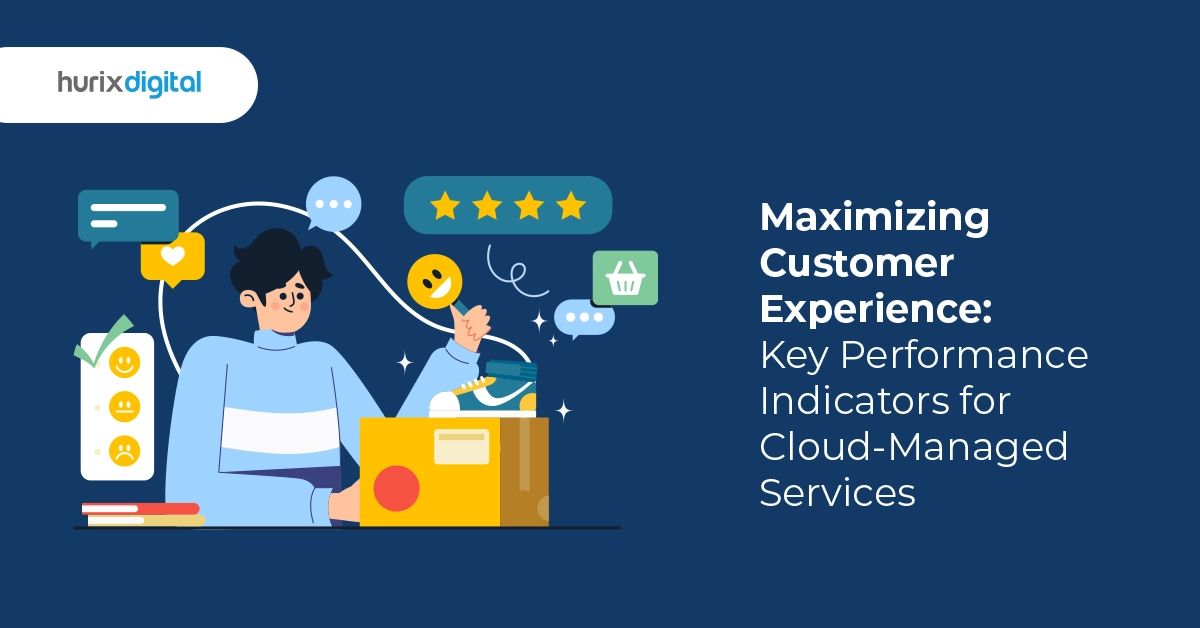Maximizing Customer Experience: Key Performance Indicators for Cloud-Managed Services
In today’s world of daily evolving digital technology, businesses are opting for cloud technology to streamline operations, enhance scalability, and drive innovation. However, managing cloud infrastructure and services can be complex and demanding, requiring specialized expertise and resources.
This is where cloud-managed services step in, offering a tailored solution to oversee and optimize cloud environments effectively.
Know all about how you can make your customers’ experience more suited to your business goals in this blog.
Table of Contents:
- What are the Different Stages of Customer Experience Post-Onboarding?
- How to Keep an Eye on Customer Experience?
- Strategic KPIs for Impactful Service Review Calls: Enhancing Customer Experience
- Conclusion
What are the Different Stages of Customer Experience Post-Onboarding?
Customer experience for cloud-managed services typically involves several key stages:
1. Service Delivery and Management
With the customer’s infrastructure now hosted on the cloud, the MSP takes on the responsibility of managing and maintaining these services. This includes monitoring performance, applying updates and patches, ensuring security and compliance, and providing technical support as needed. The MSP may offer different service level agreements (SLAs) based on the customer’s requirements, with options for 24/7 support and proactive monitoring.
2. Ongoing Support and Optimization
As the customer’s needs evolve, the MSP continues to provide support and guidance. This could involve scaling resources up or down based on demand, optimizing configurations for cost efficiency, and implementing new features or services to enhance performance. Regular reviews and assessments may also be conducted to ensure that the customer is getting the most value out of their cloud investment.
3. Feedback and Improvement
Throughout the engagement, the MSP solicits feedback from the customer to identify areas for improvement. This could be through surveys, regular check-ins, or dedicated account management meetings. By listening to the customer’s feedback and addressing any concerns or issues promptly, the MSP can continuously enhance the customer experience and strengthen the partnership.
Also Read: The Future of Content Management: AEM Cloud Manager’s Role in Driving Innovation!
How to Keep an Eye on Customer Experience?
As a cloud service provider, every partner must stay attuned to their customers’ sentiments regarding the services provided. While comprehending their feedback is essential, partners also play a pivotal role in articulating the benefits their customers derive from opting for these services. This can be effectively achieved through regular service review calls involving the core team with whom the partner interacts routinely and key business stakeholders.
Additionally, showcasing pertinent Key Performance Indicators (KPIs) can vividly illustrate the tangible value and impact of the services, fostering transparency and trust in the partnership.
Strategic KPIs for Impactful Service Review Calls: Enhancing Customer Experience
Service review calls should be scheduled regularly, occurring monthly, quarterly, and semi-annually, and aligning with agreement renewals with the respective key business stakeholders. While monthly reviews may be overseen by the Project or Operations Manager, quarterly and semi-annual reviews necessitate the involvement of higher-level decision-makers such as the Delivery Head or Head of Department, as well as the Account Manager. This multi-tiered approach enhances the overall customer experience by ensuring comprehensive oversight and alignment with strategic objectives.
The selection of Key Performance Indicators (KPIs) for these reviews should be tailored to the specific nature of the business and workload. Below are suggested KPIs that can be considered for each type of service review call, enabling partners to focus on the most relevant metrics for driving meaningful discussions and insights.
1. Highlights and Lowlights
Delivering highlights from the previous month, quarter, etc., is imperative for enhancing the customer experience and demonstrating the value of the partnership. However, supplementing these highlights with insights into any lowlights and the corresponding action items defined to address them and their progress fosters confidence among business stakeholders. This approach not only reassures stakeholders that their cloud environment is actively monitored and managed but also enhances transparency between the partner and the client, ultimately strengthening the relationship and driving mutual success.
2. Partner’s Recommendation
During a service review call, partners should effectively present the recommendations they have provided to the customer across various domains such as cost optimization, performance enhancement, and security measures, along with detailing the outcomes achieved. Employing a structured format can significantly capture the client’s attention and convey the significance of these recommendations. This can be presented as a proactive CR proposed by a partner to keep Cloud infra at an optimal level from all perspectives.

3. Operations Dashboard
The operations dashboard serves as a concise overview to guide customers through active tickets. Partners should prioritize highlighting tickets that demand immediate attention from the customer.

3. Operations Dashboard
The operations dashboard serves as a concise overview to guide customers through active tickets. Partners should prioritize highlighting tickets that demand immediate attention from the customer.
4. Severity-wise KPIs
Various KPI metrics, such as average response time, average resolution time, and adherence to service level agreements (SLAs), should be systematically captured according to severity levels and meticulously presented during service review calls. This practice not only demonstrates the partner’s attentiveness but also instills confidence in the customer, reassuring them that their cloud infrastructure is in the capable hands of a competent team.
5. KPIs Outside the Boundaries of SLA
Several key performance indicators (KPIs) may not be explicitly outlined within the service level agreement (SLA) yet capturing and presenting them during service review calls is essential for ensuring the best possible customer experience. These additional KPIs provide valuable insights into various aspects of the service delivery that directly impact the customer’s satisfaction and overall perception of the partnership. By monitoring and reporting on these metrics, the partner demonstrates a commitment to exceeding expectations and continuously improving the quality of service provided. This proactive approach fosters transparency, trust, and collaboration between the partner and the customer, ultimately enhancing the overall success of the partnership.
- Proactive v/s Reactive: A partner should define internal targets for detecting incidents proactively by having the right monitoring system in place. A reactive incident is something that a client reports to a partner and should be kept at a minimum. Proactive incident detection through monitoring systems not only helps prevent service disruptions and performance issues but also demonstrates the MSP’s commitment to delivering exceptional service and value to the customer, ultimately enriching the overall customer experience.

- Change Success Rate: In ITIL, a change request is defined as a formal proposal to alter or enhance an IT service, configuration item, or other aspects of the IT infrastructure. It is typically initiated when a change is required to address a problem, implement improvements, or introduce new features or functionalities. A change request follows a defined process within the ITIL framework, involving the submission, assessment, approval, implementation, and review stages. This process ensures that changes are properly evaluated, authorized, and managed to minimize risks and disruptions to IT services and business operations. Despite proper planning sometimes Changes disrupt service or may not meet the desired outcome. This should be captured post-execution of every change and presented to the customer during service review calls. Presenting the change request success rate not only enhances transparency, trust, and predictability but also enables continuous improvement and alignment with the customer’s business goals, ultimately contributing to a positive customer experience.

6. Customer Feedback
In every service review call, it’s crucial to set aside a dedicated portion towards the end of the meeting to comprehensively evaluate the overall customer experience over the past month or quarter. This dedicated slide serves as a pivotal moment to assess the collective impact of the services provided on the customer’s satisfaction and operational efficiency.
Positive feedback received from customers during this period should be emphasized and celebrated within the team, recognizing the individuals whose efforts contributed to these positive outcomes. This recognition not only boosts morale but also reinforces a culture of excellence and customer-centricity within the organization.
Conversely, any concerns or issues raised by customers should be meticulously recorded and acknowledged. These concerns serve as valuable insights into areas where improvements or corrective actions may be needed to enhance the customer experience metrics.
7. Progress on Action Items
Action Items recorded from previous service review calls and RCA of problem tickets should be presented along with their status and progress. An action plan should be promptly created to address each concern, outlining specific steps, responsibilities, and timelines for resolution. By proactively addressing customer concerns and tracking the progress of these actions, the organization demonstrates its commitment to continuous improvement and responsiveness to customer needs. This proactive approach not only fosters trust and confidence but also strengthens the partnership between the service provider and the customer, ultimately leading to greater satisfaction and long-term loyalty.
Also Read: How is the Higher-Ed Industry Using Cloud Transformation?
Conclusion
In summary, leveraging KPIs and presenting them effectively enables MSPs to not only meet but exceed customer expectations, driving superior customer experiences and business outcomes in the rapidly evolving landscape of managed services. By continuously refining their service offerings and delivering value-added insights, MSPs can differentiate themselves in the market and become trusted advisors to their customers on their cloud journey.
Choosing from a sea of managed service providers can be a daunting task. Hurix Digital, an expert in providing these services, is an excellent option for business, be it big or small.
Contact our Cloud Managed Services experts to have a better customer experience for your MSP tenure by partnering with Hurix Digital.











